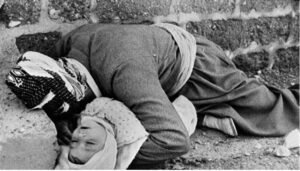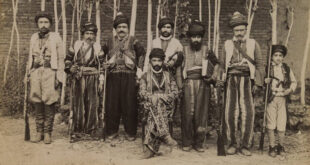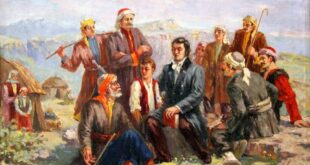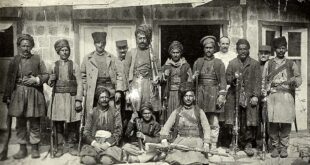 On March 16, 1988, the city of Halabja was subjected to the most heinous crime against humanity, which is the bombing of the city with chemical weapons. Over 5,000 innocent people were martyred as a result of this crime, including women, the elderly, and children and more than 10,000 were injured.
On March 16, 1988, the city of Halabja was subjected to the most heinous crime against humanity, which is the bombing of the city with chemical weapons. Over 5,000 innocent people were martyred as a result of this crime, including women, the elderly, and children and more than 10,000 were injured.
What this martyred city was subjected to is a crime that humanity condemns. On March 16, 1988, tears have fallen from the most beautiful innocent eyes who had suffocated from the poisonous gas that was poured on the city resulting in the death of thousands of Kurds and the injury of thousands more. The aftermath of the tragedy was even worse than the first day of it, as the incident caused many diseases in the people of the city for many years that followed.
The crime began a few minutes before eleven o’clock in the morning when the innocent people of the city were astonished by a miserable death, and their simple dreams went into the yellow wind when four warplanes spread destruction and death that smelled like apples, for the people to inhale it quickly, as the planes rose by an order from the then commander of the Iraqi armed forces and the president of Iraq, Saddam Hussein. The crime was executed by the criminal Ali Hassan al-Majid, know as chemical Ali, who bombed the city with lethal weapons consisting of mustard and cyanide gas to end the lives of thousands of civilians and commit the most terrible humanitarian catastrophe.
Soon after, the city was covered with the bodies of the martyrs. Sprawled on the floor, families embraced each other. The women had their babies in their arms when they were caught by surprise with a terrible death. The children’s faces, free of suspicion, were darkened by the poisonous gases.
This notorious crime has few equivalents in the history of humanity as a whole, and it can be described as the crime of the era. The fallen Baath regime did not hesitate to bomb the safe civilians of the city of Halabja with chemical weapons, a crime that did not differentiate between women and men, and between the elderly and children, those pure souls that fell before the doors of their homes, the alleys and streets of that lofty city to form an indelible human painting in the memory of humanity, a painting that expresses the tragedy of peoples who were deprived of their natural right to a safe and dignified life.
March 16, 1988, the date of of bombing Halabja with chemical weapons, must remain a life-changing date in the lives of all Iraqis to be a lesson to prevent the return of dictatorship to this country. This great and deep wound must remain in memory and be taught in schools so that subsequent generations know the meaning of dictatorship and learn about its crimes against our people, and stand against it with full force.
This crime that was carried out by the men of the former Baath regime against the sons of the people of Kurdistan did not go unpunished, as the symbols and leaders of the fallen regime were arrested in 2003 after the fall of the buried dictator and the liberation of Iraq from oppression and tyranny at the hands of the coalition forces.
After that, the People’s Court in Baghdad began retributing the criminals, and then the Supreme Criminal Court was formed and began hearing the Halabja case.
On 5 November 2006, Saddam Hussein was found guilty of crimes against humanity and sentenced to death by hanging. Saddam’s half-brother, Barzan Ibrahim, and Awad Hamed al-Bandar, head of Iraq’s Revolutionary Court in 1982, were convicted of similar charges. The verdict and sentencing were both appealed, but subsequently affirmed by Iraq’s Supreme Court of Appeals.
Saddam was hanged on the first day of Eid al-Adha, 30 December 2006, despite his wish to be executed by firing squad (which he argued was the lawful military capital punishment citing his military position as the commander-in-chief of the Iraqi military). The execution was carried out at Camp Justice, an Iraqi army base in Kadhimiya, a neighborhood of northeast Baghdad.
As for Ali Hassan Majid, his trial began on 21 August 2006, in acrimonious circumstances when al-Majid refused to enter a plea. He subsequently had a not guilty plea entered on his behalf by the court.
He was unapologetic about his actions, telling the court that he had ordered the destruction of Kurdish and Assyrian villages because they were “full of Iranian agents”. At one hearing, he declared: “I am the one who gave orders to the army to demolish villages and relocate the villagers. The army was responsible to carry out those orders. I am not defending myself. I am not apologizing. I did not make a mistake.”
On 24 June 2007, the court returned a verdict of guilty on all counts. The presiding judge, Mohamed Oreibi al-Khalifa, told al-Majid: “You had all the civil and military authority for northern Iraq. You gave orders to the troops to kill Kurdish and Assyrian civilians and put them in severe conditions. You subjected them to wide and systematic attacks using chemical weapons and artillery. You led the killing of villagers. You … committed genocide. There are enough documents against you.”
He received five death sentences for genocide, crimes against humanity (specifically willful killing, forced disappearances and extermination), and war crimes (intentionally directing attacks against a civilian population). He was also sentenced to multiple prison terms ranging from seven years to life for other crimes. As his sentences were upheld, under Iraqi law, sentence was to be carried out by hanging, subject to the convictions being upheld following an automatic appeal, and he was to be executed in the following 30 days along with two others – Sultan Hashim Ahmad al-Tai, military commander of the Anfal campaign; and Hussein Rashid Mohammed, deputy general commander of the Iraqi armed force, assistant chief of staff for military operations, and former Republican Guard commander. However, the executions were postponed to 16 October, because of the arrival of the holy month of Ramadan. He was supposed to be executed 16 October 2007, but the execution was delayed when Iraqi President Jalal Talabani and Vice President Tariq al-Hashemi expressed opposition to the sentences of al-Majid’s co-defendants and refused to sign the execution orders. He then entered into a legal row with Iraqi Prime Minister Nouri al-Maliki, and as a result the Americans refused to hand any of the condemned prisoners over until the issue was resolved.
In February 2008 an anonymous informant stated that Ali Hassan al-Majid’s execution was finally approved by former Iraqi President Mam Jalal, al-Hashemi, and al-Maliki; this was the final hurdle in the way of the execution.
On 2 December 2008, al-Majid was once again sentenced to death, but this time for playing a role in killing between 20,000 and 100,000 Shi’ite Muslims during the revolt in southern Iraq that followed the 1991 Persian Gulf War. On 2 March 2009, al-Majid was sentenced to death for the third time, this for the assassination of Grand-Ayatollah Mohammad al-Sadr in 1999.
The Iraqi Cabinet put pressure on the Presidential council on 17 March 2009 for Al-Majid’s execution.
The situation was similar on 17 January 2010 prior to 9 am (GMT); a fourth death penalty was issued against him in response to his acts of genocide against Kurds in the 1980s. He was also convicted of killing Shia Muslims in 1991 and 1999. Alongside him in the trial was former defense minister Sultan Hashem, who was also found guilty by The Iraqi High Tribunal for the Halabja attack and sentenced to 15 years’ imprisonment. Al-Majid was executed by hanging on 25 January 2010. He was buried in Saddam’s family cemetery in al-Awja the next day; near Saddam’s sons, half-brother and the former vice president, but outside the mosque housing the tomb of Saddam. While he was sentenced to death on four separate occasions, the original 2007 verdict sentenced him to five death sentences, and so the combined tally of death sentences handed out was eight.
Amnesty International’s Middle East and North Africa Director Malcolm Smart later criticized the execution as “only the latest of a mounting number of executions, some of whom did not receive fair trials, in gross violation of human rights…”
 History of Kurdistan
History of Kurdistan



